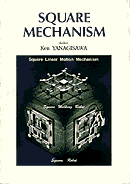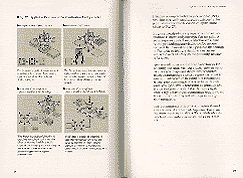
表紙

裏表紙

本文例
 表紙 |
 裏表紙 |
 本文例 |
CONTENTS
1. Recognition of The Square_________________________7
1) Recognition in The Gene Level__________ 8
2) Recognition Like Nested Boxes__________9
3) Making Coordinate Axes_____________12
4) Recognition of Four_______________14
5) From Square to Cube_______________15
2. Essential Elements of A Mechanism__________________ 17
3. A Linear Motion Square Mechanism___________________19
1) Four-Supporting Point Theory_________ 20
2) Four Side-Driving Theory___________ 24
(1) High Positioning Accuracy_________ 26
(2) Low Moment Load______________ 30
3) Four Side Pre-Load Theory___________33
4) Direct Motion Theory______________ 37
5) Torsion Effect Theory_____________ 41
4. A Rotary Motion Square Mechanism_______ 51
1) Square-Rotary Motion Theory__________ 52
(1) Compact Mechanism_____________ 53
(2) Making Greater Torque____________ 55
(3) Higher Rotary Balance____________ 56
2) Rotary Motion Theory______________ 62
(1) A Multiple Rotational Axes__________ 63
(2) Perfect Synchronous Rotation_________68
(3) No Rotational Speed Difference________72
3) Rotary-Linear Motion Theory__________73
5. Applications of The Linear Motion Square Mechanism_____ 77
1) A Square-Robot__________________82
(1) A Basic Square-Robot____________83
a) A Ball Screw-Synchronous Type______83
b) A Torsion-Synchronous Type_______ 84
c) Direct Drive Type_____________ 84
(a) A Ball Screw Type___________ 85
(b) A Hydraulic Type____________ 85
(c) A Link Type______________ 87
(2) A Combined Square-Robot (1)________ 87
a) A Twin Arm Type______________87
b) A Multi Arm Type______________94
c) A Multi Arm Assembling Center_______94
(3) A Combined Square-Robot (2)_________100
a) A Combination Arm Type__________100
(4) A Combined Square-Robot (3)________106
a) A Double Face Type_____________ 106
(5) An Open Type Square-Robot_________ 119
a) A Ball Screw-Synchronous Type______ 119
b) A Torsion-Synchronous Type________ 119
(6) An Arm-Square Robot____________ 122
(7) A Cubic-Square Robot____________ 126
2) A Square-Walking Robot____________ 128
(1) A Basic Square-Walking Robot________ 129
(2) An Advanced Square-Walking Robot_____ 137
(3) A Vehicle-Walking Robot System_______ 137
3) A Table Type Robot______________ 142
6. Applications of Rotary Motion Square Mechanisms_______151
1) A Square-Rotary System____________ 152
(1) A Square-Rotary Motion Device________ 152
(2) A Square-Rotary Table____________154
2) A Rotary Motion System____________ 159
(1) Multiple Axes Rotation___________ 159
(2) Synchronous Rotation____________ 162
(3) Round Motion_________________166
3) A Rotary-Linear Motion System________169
7. A Composite Rotary-Linear Motion Square Mechanism_____171
8. The Future of The Square Mechanism__________________175
Already 15 years have passed since I started to study and manufacture "Square Mechanism".
During the period I have been deeply engaged in the Square World as a life work.
To study mechanisms is very metaphysical work, and it is affected by intuition and inspiration.
Electrics and electronics are advancing rapidly but mechanics is not.
Machines are assembled with mechanical elements, for example, gears, chains, ..... Engines have cranks, and pumps have impellers.
These mechanisms have not changed for a long time.
Namely epochal mechanisms have not been developed in the mechanical field.
I think the reason that no epochal mechanisms have appeared is the difference in developmental techniques between the mechanical field and the electronic field.
In the electronic field, technology is developed with logical ideas, which can be theorized and formulated.
Namely it is developed in the so-called left-brain world.
On the other hand, in the mechanics, technology is developed with idea based on experiences.
Namely it is developed in the right-brain world.
"Mechanics is ruled by analogous ideas; electrics and electronics are ruled by digital ideas."
Women often take part in business and industrial fields these days.
I have met many superior women engineers in the electronic field but I have met few superior women engineers in the mechanical field.
I think this fact is caused by the difference between analogous ideas and the digital ideas.
In the electronics field, judgement is executed in binary: "1" or "0", so most results can be gained logically and mathematically.
In the mechanical field, in designing a machine, for example, a designer must calculate the basic toughness, etc. of the machine, but he does not have to do this for each of the hundreds of parts.
They will be designed on the basis of his intuition.
In the case of designing a cover of a machine, male designers use anologous thinking, so they usually think that a metal plate having a thickness of about 2 mm is enough for the cover.
But most female designers can't accept such unclear measurement, they think the thickness must not be about 2 mm; it must be exactly 2 mm.
1.8 mm and 2.2 mm are not acceptable.
There is much in the mechanical design field that is vague but precise answers exist in mechanics.
Some designers or engineers are able to know the precise answers because of their highly trained intuition.
It is difficult for female designers to have this highly trained intuition.
This intuition grows through experiences.
For example, boys play by climbing and jumping on an oil tank, so that they naturally know the toughness of a metal plate having a thickness of about 2 mm.
Girls playing with dolls can't develop such an intuition.
For this reason, there are few superior female engineers or designers in the mechanical field.
But manly women have increased in present society, so superior women engineers must increase in the near future.
How should we face the mechanical field which is ruled by analogous intuition?
"Intuitiveness is poetical and of literary flavor. Metaphysics is artistic and philosophical."
Is mechanics poetical, of literary flavor, artistic and philosophical?
My answer is indeed yes.
The basics of a mechanism are engineering knowledge and the technology based thereon.
But they are required after intuitive inspiration has been hit upon.
The development of a mechanism can't occur without inspiration.
An idea based on inspiration is explained, proved and guaranteed by the engineering knowledge and the technology, which have been compiled in mechanics.
To develop mechanisms, we don't use any manuals, which are usually used in the electronics field.
We have to be inspired in a moment.
If we stick to conventional mechanical knowledge, etc., the inspiration and new idea based thereon are obstructed.
Now I have to teach my stuff members, as a president, but strongly feel the difficulty teaching the inspiration.
Even if they see the same thing, all of them can't be inspired.
Why? Seeing is different from being inspired.
What type of man is a proper mechanical engineer?
The answer is also a vague one: an impressive and romantic man who has dreams, I think.
In childhood, he was looking at flowers all day long; he was vacantly seeing an ocean on a bulwalk without having dinner even though his friends were searching for him; .......
Sharp men usually loses unique inspiration because of their sharpness.
While, a man who is apparently a tactless man, but a sensitive man, is able to comprehend the essential qualities of mechanisms.
You ara such a man.
I have studied the Square Mechanism from every angle.
I have sometimes done this in a literary sense, a historical sense, a philosophical sense, an artistic sense, an economical sense, etc., and all of these were effective for mechanical study.
Truth for one matter is truth in every sense.
I now strictly think I could develop the Square Mechanism since I have studied it from every angle.
Recollecting the progress of developing the Square Mechanism, there were many things and affairs in that progress.
How many times have I talked about a first square mechanism, which was made on an experimental basis, in a factory until midnight?
Once I thought I talked with her for only ten minutes but the clock said it was one or two hours.
And another time, I drove a car to a very very far place beyond my destination because I was concentrating on thoughts about the mechanism.
At any rate, I am very happy to make a first book in which all the study data of the Square Mechanism are compiled.
The Square Mechanism is protected by one hundred patents or more in Japan and other countries.
I disclose the lines of the Square Mechanism in this book so as to contribute the development of mechanics.
I wrote this book as easily as possible and with examples.
There may be some unclear descriptions, so I respectfully ask my readers to read this book with superior knowledge and heartful understanding.